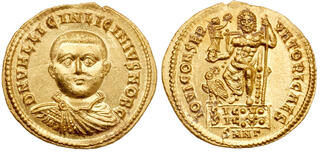| Ira & Larry Goldberg Coins & Collectibles > Auction 137 | Auction date: 29 January 2024 |
| Lot number: 1055 Price realized: 41,000 USD (Approx. 37,974 EUR) Note: Prices do not include buyer's fees. | Show similar lots on CoinArchives Find similar lots in upcoming auctions on |
| Lot description: Licinius II. Gold Aureus (5.31 g), Caesar, AD 317-324. Nicomedia, AD 320. D N VAL LICIN LICINIVS NOB C, bare-headed, draped and cuirassed bust of Licinius II facing. Reverse: IOVI CONSER-VATORI CAES, Jupiter seated facing on platform inscribed SIC V / SIC X, holding Victory on globe and scepter; at feet to left, eagle standing left, head turned right and holding wreath in beak; SMNΓ. RIC 42; Depeyrot 31/2; Calicó 5152a. Perfectly centered with a crisp strike. Fully lustrous. A spectacular rarity! NGC grade MS; Strike: 5/5, Surface: 3/5. Estimated Value $50,000 - UP Struck to celebrate Licinius Caesar's quinquennalia or 5th year on the throne as his father's heir, when he was only eight years old, this magnificent aureus with a fully frontal facing portrait is one of the earliest facing portraits on Roman coinage. Prior to this issue, which also includes a nearly identical aureus of Licinius I but with a bearded portrait, there were only two other Roman gold coins with portraits depicting the ruler in a facing pose: an aureus of Maxentius struck in ca. 310-312, also shown bearded, and a solidus of Constantine the Great struck in 316, but showing him clean shaven and nimbate. Frontal poses would soon become the norm however: Constantius II utilized a facing helmeted portrait at his eastern mints, and this would become the standard expression of the ruler on gold coinage throughout the subsequent late Roman and Byzantine periods.The facing portrait solidi of the Licinii, as mentioned above, were struck to celebrate the imperial vows taken to mark the conclusion of five successful years on the throne and the hope for a further half decade of rule. The normal expression for this was VOT V MVLT X, but here it takes the unusual form SIC V SIC X, which is inscribed on the base upon which Jupiter's throne sits. The type depicting the head of the Graeco-Roman pantheon, Jupiter, seated on a high-backed throne in a frontal pose, holding a globe supporting the goddess Victory who crowns him with a wreath and holding his scepter, is also a full of meaning. It is derived from the famous statue of Zeus said to have been made by the artist Phidias for the temple of Zeus at Olympia in Greece - home to the Olympic Games - and was said to have been cast in gold and ivory. The corresponding legend, IOVI CONSERVATORI, claims the god's divine protection for the father and son.While Licinius and Constantine jointly ruled the vast Roman Empire, they did not do so in harmony. They were, in fact, adversaries, with both aspiring to sole rule. Constantine was a monotheist, probably at the time this coin was struck strongly Christian, while Licinius worshipped the traditional Roman gods. The depiction of Jupiter on these Licinian aurei, with the corresponding legend describing Jupiter as their protector, served as an expression of Licinius' discontent with joint rule. It would not be long until the final clash between the two emperors in 324, with Constantine being victorious. At first, at the pleading of his sister, the wife and mother of the Licinii, Constantine spared them. However, it was not long before he succumbed to expedience and changed his mind, having both father and son executed. The boy Licinius, Constantine's nephew, was just thirteen years old when his uncle had him murdered. Ex Millennia Collection (Goldberg 46, 26 May 2008), lot 143. |  |


